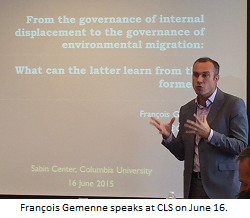Jessica Wentz
Associate Director and Postdoctoral Fellow
Saturday, June 20 is World Refugee Day – an occasion for recognizing the plight of millions of people who have been forced to leave their homes due to conflict, persecution, natural disasters, and other circumstances beyond their control. The United Nations Refugee Agency (UNHCR) and other civil society organizations will be hosting a variety of events to honor these individuals and raise funds to help support their resettlement or return home.
The magnitude of the refugee crises was highlighted in the UNHCR’s annual Global Trends Report, which was released yesterday (June 18). The report found that worldwide displacement by the end of 2014 had reached an all-time high, with a staggering 59.5 million forcibly displaced by wars and conflict. Although the report did not address displacement induced by natural disasters, environmental degradation, or climate change, the UNHCR has expressed serious concerns about these forms of displacement in other publications. The agency has also recognized that armed conflicts like those discussed in the Global Trends Report are often “rooted in environmental factors” such as water scarcity and land degradation, and that many of these problems will be exacerbated by the impacts of climate change.
There is very little data on the number of people that are currently displaced by environmental degradation. The Internal Displacement Monitoring Centre (IDMC) estimates that 22 million people were displaced by disasters in 2013, but there is no system to monitor and track the number of people who are currently displaced by other environmental- and climate-related phenomena. While it is generally understood that the impacts of climate change will significantly increase the number of persons displaced both within and across borders, it is impossible to predict the future scale of movement in this context.
Despite this uncertainty, it is critically important that we develop an agenda for managing displacement in the context of climate change. Provisions for a “climate displacement coordination facility” are included in the draft negotiating text for the upcoming United Nations Framework Convention on Climate Change (UNFCCC) conference, but there is no guarantee that these will make it into the final agreement. As noted in a previous blog post, the Sabin Center has been advocating for the U.S. to demonstrate leadership on this topic, either by supporting the development of the climate change displacement coordination facility or by initiating a separate negotiation to address climate-induced displacement. Unfortunately, the U.S. government has yet to take a stand on this issue.
What can be done to address this looming crisis? Some scholars and advocacy groups have sought to create a special convention which would frame the rights of persons displaced by climate change and the corresponding obligations of countries with respect to those persons. However, it is unlikely that major players like the U.S. would sign onto such a treaty if it contained any meaningful commitments—such as an obligation to accept displaced persons or provide funding to support their resettlement.
François Gemenne, a professor at Sciences Po and a leading expert on the topic of climate-induced displacement, outlined a different approach during a presentation at Columbia Law School this week. He recommends that a set of guiding principles, similar to the UN Guiding Principles on Internal Displacement, could be used to frame countries’ obligations with respect to persons displaced by the impacts of climate change and other environmental phenomena. He recognizes that a soft law mechanism may not provide a complete set of protections or a perfect framework for managing climate-induced displacement. However, a non-binding instrument could restate the fundamental rights of the environmentally displaced and could serve as a basis for the adoption of domestic legislation. He identifies the protection agenda of the Nansen Initiative, which is already underway, as a possible foundation for the development of such principles.
To learn more about his research, see François Gemenne & Pauline Brücker, From the Guiding Principles on Internal Displacement to the Nansen Initiative: What the Governance of Environmental Migration Can learn from the Governance of Internal Displacement (2015).


